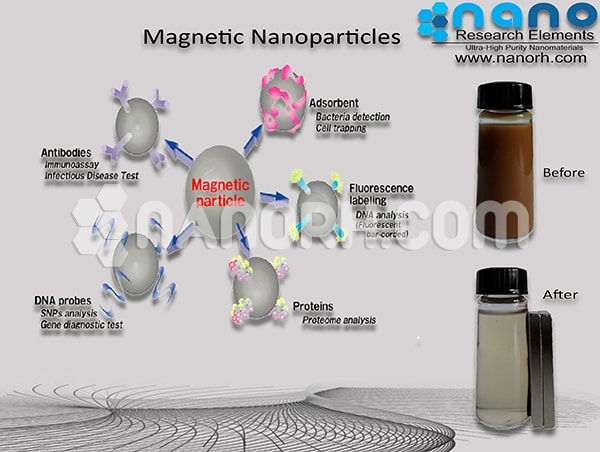MAGNETIC NANOPARTICLES
MAGNETIC NANOPARTICLES
INTRODUCTION
Magnetic nanoparticles are a class of nanoparticles that can be controlled utilizing attractive fields. Such particles usually comprise of two segments, an attractive material, regularly iron, nickel and cobalt, and a substance segment that has usefulness. While nanoparticles are littler than micrometer in measurement (normally 1– 100 nanometers), the bigger smaller scale dabs are 0.5– 500 micrometer in breadth. Magnetic nanoparticles groups that are made out of various individual Magnetic nanoparticles are known as attractive nanobeads with a distance across of 50– 200 nanometers. Magnetic nanoparticles bunches are a reason for their further attractive gathering into attractive nanochains. The Magnetic nanoparticles have been the focal point of much research as of late in light of the fact that they have alluring properties which could see potential use in catalysis including nanomaterial-based impetuses, biomedicine and tissue particular focusing on, attractively tunable colloidal photonic precious stones, small scale fluidics, attractive reverberation imaging, attractive molecule imaging, information stockpiling, natural remediation, nanofluids, and optical channels, imperfection sensor and cation sensors.
POTENTIAL APPLICATIONS
A wide assortment of potential applications has been conceived. Since Magnetic nanoparticles are costly to deliver, there is enthusiasm for their reusing or for very specific applications. They are just utilized in logical research. A modern utilize presently can't seem to be built up. The potential and adaptability of magnetc science emerges from the quick and simple partition of the Magnetic nanoparticles, dispensing with dull and exorbitant detachment forms typically connected in science. Moreover, the Magnetic nanoparticles can be guided by means of an attractive field to the coveted area which could, for instance, empower pinpoint accuracy in battling disease.
RESTORATIVE DIAGNOSTICS AND MEDICATIONS
Magnetic nanoparticles have been examined for use in an experimental cancer treatment called magnetic hyperthermic in which an alternating magnetic field (AMF) is used to heat the nanoparticles. To achieve sufficient magnetic nanoparticles heating, the AMF typically has a frequency between 100–500 kHz, although significant research has been done at lower frequencies as well as frequencies as high as 10 MHz, with the amplitude of the field usually between 8-16kAm−1.
Magnetic nanoparticles can be utilized for the identification of disease. Blood can be embedded onto a smaller scale fluidic chip with Magnetic nanoparticles in it. These Magnetic nanoparticles are caught inside due to a remotely connected attractive field as the blood is allowed to move through. The Magnetic nanoparticles are covered with antibodies focusing on tumor cells or proteins. The Magnetic nanoparticles can be recuperated and the connected disease related atoms can be examined to test for their reality.
Magnetic nanoparticles can be conjugated with sugars and utilized for identification of microscopic organisms. Press oxide particles have been utilized for the identification of Gram negative microscopic organisms like Escherichia coli and for discovery of Gram positive microorganisms like Streptococcus suis.
MAGNETIC IMMUNOASSAY
Magnetic immunoassay (MIA) is a novel kind of analytic immunoassay using attractive nanobeads as marks in lieu of traditional, catalysts, radioisotopes or fluorescent moieties. This test includes the particular authoritative of a counter acting agent to its antigen, where an attractive name is conjugated to one component of the combine. The nearness of attractive nanobeads is then distinguished by an attractive peruser (magnetometer) which estimates the attractive field change initiated by the globules. The flag estimated by the magnetometer is relative to the analyte (infection, poison, microscopic organisms, cardiovascular marker, and so forth.) amount in the underlying example.
WASTE WATER TREATMENT
Thanks to the easy separation by applying a magnetic field and the very large surface to volume ratio, magnetic nanoparticles have a potential for treatment of contaminated water. Magnetic nanobeads or nanoparticles clusters composed of FDA-approved oxide super paramagnetic nanoparticles (e.g. maghemite, magnetite) hold much potential for waste water treatment since they express excellent biocompatibility which concerning the environmental impacts of the material is an advantage compared to metallic nanoparticles.
CATALYST SUPPORT
Magnetic nanoparticles are of potential use as an impetus or impetus underpins. In science, an impetus bolster is the material, as a rule a strong with a high surface region, to which an impetus is attached. The reactivity of heterogeneous impetuses happens at the surface molecules. Subsequently, awesome exertion is made to amplify the surface region of an impetus by circulating it over the help. The help might be dormant or take part in the synergist responses. Normal backings incorporate different sorts of carbon, alumina, and silica. Immobilizing the reactant fixate over nanoparticles with an expansive surface to volume proportion tends to this issue. On account of Magnetic nanoparticles it includes the property of simple a partition. An early precedent included a rhodium catalysis joined to Magnetic nanoparticles.
FUTURE ASPECTS
The eventual fate of Magnetic nanoparticles in biomedical applications holds extraordinary guarantee particularly in the zone of infection finding, early discovery, cell and profound tissue imaging, sedate/quality conveyance and in addition multifunctional therapeutics. Despite the fact that, Feraheme (US FDA endorsed) is being utilized by the shoppers, a greater amount of such Fe-NPs-based materials should be looked into and made accessible to the buyer advertise. The ebb and flow accentuation of sub-atomic solution is to grow more novel instruments, which can be utilized for beginning period malady determination and a greater amount of purpose of-care diagnostics. Coordination of nanomaterials, could broaden the development of the theranostic stage, which joins therapeutics with diagnostics. Such endeavors would fundamentally make the finding forms easier, speedier and less intrusive. Customized medication is additionally picking up consideration and it is normal that the coordination of nanotechnology could bring about larger results. In coming years, multifunctional attractive NPs would be an alluring material for biomedical applications and may change the standard plan of action of pharmaceutical enterprises.

